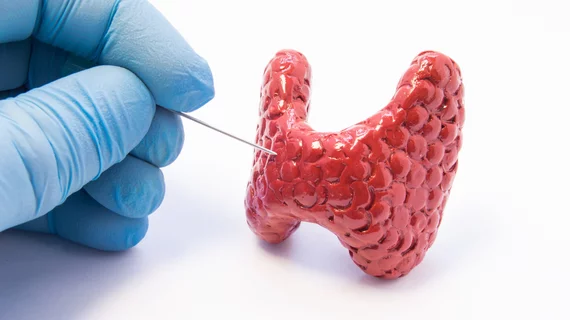Risk prediction algorithm slashes number of unnecessary thyroid nodule biopsies
Experts have developed a machine learning model capable of accurately predicting the malignancy risk of thyroid nodules using ultrasound images.
Thyroid nodules are common, with research estimating up to half of the population will develop one at some point during their lifetime. Although the vast majority of nodules, identified incidentally or otherwise, are benign, many are referred for biopsy as a precaution to rule out malignancy. This represents a significant burden for patients and the healthcare system.
Numerous efforts have been made to better predict the likelihood of malignancy based on imaging features seen on ultrasound exams. The emergence of artificial intelligence- and machine learning-based applications has presented researchers with new opportunities to achieve this.
A new paper in European Radiology details some of these efforts, highlighting the potential of ML to reduce unnecessary biopsy procedures on benign thyroid nodules.
Researchers used ultrasound images from over 1,000 nodules to develop and train eight risk prediction ML models. The models were trained to spot key imaging features indicative of malignancy. Logistic regression was used to compare the accuracy of the highest performing model to that of the American College of Radiology Thyroid Imaging Reporting and Data System (ACR TI-RADS) and American Thyroid Association (ATA) guidelines.
Based on measures of sensitivity, specificity, positive predictive value and negative predictive value, one model—the XGBoost algorithm—significantly outperformed all others and both the TI-RADS and ATA guidelines. What’s more, the algorithm also reduced the rate of unnecessary biopsies, with just 7% of its predictions leading to the procedure compared to 43% and 63% for TI-RADS and ATA recommendations.
Experts involved in the model’s development say their findings highlight the promise of machine learning to improve diagnostic processes related to thyroid nodule assessments.
“This study demonstrated the capability of ML approaches in enhancing the accuracy of predicting thyroid malignancy risks as well as their potential benefits in optimizing healthcare resources by reducing unnecessary FNA rates,” Seyed Mahdi Hosseini Sarkhosh, with the Department of Industrial Engineering at the University of Garmsar in Iran, and colleagues note. “Using the proposed model through a web-based tool can facilitate clinical judgments in thyroid nodule management and personalized treatment.”
Learn more about the team’s findings here.

